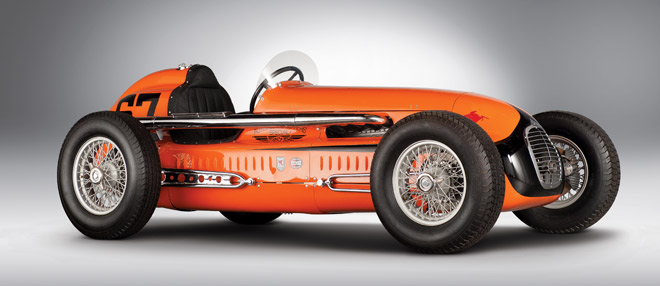Among the many builders of Indianapolis 500 cars, the names Frank Kurtis, A.J. Watson and Quinn Epperly stand out, primarily for their work during the glorious era of the 1950s through the mid-1960s. Over the years, however, many other talented and resourceful builders turned their hands to the craft. One of these was Russell Snowberger. His heyday came during the so-called “Junk Formula” years, when Indy rules were skewed toward production engines.
Louis Rassey, the owner of a gas station and, later, a machine shop, was a racing aficionado who leapt headlong into the sport after World War II, using Snowberger chassis and Meyer-Drake Offenhauser power. Eugene Casaroll’s highly successful Automobile Shippers company sponsored Rassey’s entries at the Indianapolis 500 from 1946 through 1950. The car offered here from the Milhous Collection is confirmed as car number 36, entered by Louis Rassey as part of his two-car effort in the 1950 Indianapolis 500 and sponsored by Eugene Casaroll’s Automobile Shippers.
Driven by George Lynch, the car offered here did not manage to qualify for the rain-shortened race in 1950. Following Indianapolis, this Snowberger-Offy was extensively campaigned on the USAC circuit with a roster of colorful drivers whose names will be familiar to most fans of the era, including “Spider” Webb, Bill Schindler, Johnny Fredricks, George Hammond, Fred Agabashian and of course George Lynch, who piloted the car three additional times that year after Indianapolis. Its best finish for 1950 was during September at Pikes Peak, where Hammond finished in 4th.
Having enjoyed pride of place in the lobby of the Milhous Collection for years, it remains both a fitting tribute to the heroic era of American motorsports and a great example of the ingenuity and competitive spirit displayed annually at Indianapolis. As such, it wonderfully exemplifies America’s rich racing legacy.

